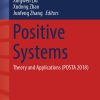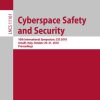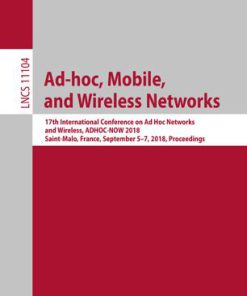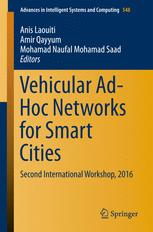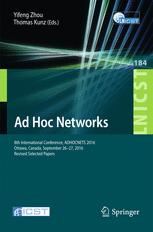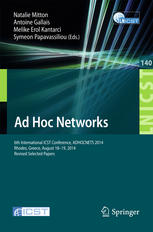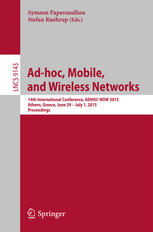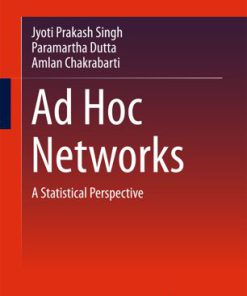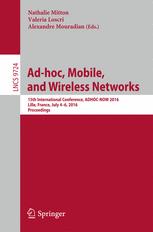Ad Hoc Mobile and Wireless Networks 1st edition by Luigi Alfredo Grieco 3030617459 9783030617455
$50.00 Original price was: $50.00.$25.00Current price is: $25.00.
Ad Hoc Mobile and Wireless Networks 1st edition by Luigi Alfredo GriecoEBOOK_TITLE EBOOk_EDITION by Author1, Author2 – Ebook PDF Instant Download/Delivery:3030617459 ,9783030617455
Full download Ad Hoc Mobile and Wireless Networks 1st edition after payment
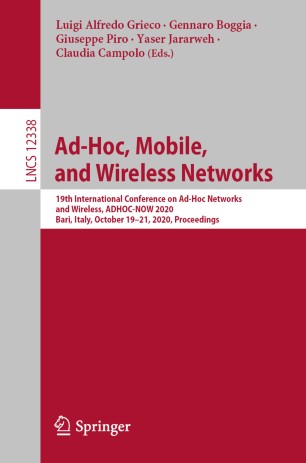
Product details:
ISBN 10:3030617459
ISBN 13:9783030617455
Author: Luigi Alfredo Grieco
This book constitutes the refereed proceedings of the 19th International Conference on Ad-Hoc, Mobile, and Wireless Networks, ADHOC-NOW 2020, held in Bari, Italy, in October 2020.*
The 19 full and 4 short papers presented were carefully reviewed and selected from 39 submissions. The papers provide an in-depth and stimulating view on the new frontiers in the field of mobile, ad hoc and wireless computing. They are organized in the following topical sections: intelligent, programmable and delay- and disruption- tolerant networks; internet of drones and smart mobility; internet of things and internet of medical things; secure communication protocols and architectures; and wireless systems.
Ad Hoc Mobile and Wireless Networks 1st Table of contents:
1 Introduction
2 Trust and User Experience Framework
2.1 Experiment Lifecycle
2.2 Testbed Evaluation
3 Reputation-Based Trust Mechanism Implementation
3.1 Involved Entities
3.2 Description
4 Performance Evaluation
4.1 Real User Experimentation
4.2 Simulated Experimentation
5 Concluding Remarks
References
Social-Based Routing with Congestion Avoidance in Opportunistic Networks
1 Introduction
2 Congestion in ONs with Social-Based Routing
2.1 Social-Based Routing Algorithms
2.2 Experimental Setting
2.3 The Congestion Problem
3 Solutions for the Congestion Problem
3.1 The Algorithms Outer and LowerEps
3.2 Experimental Results
4 Conclusions
References
Maximum Lifetime Broadcast in Mobile Sensor Networks
1 Introduction
2 Related Work
3 Problem Definition
3.1 System Model
3.2 Problem Definition
4 Evaluated Algorithms
4.1 LPrim
4.2 LMCP
4.3 LCDS
5 Evaluation and Analysis
5.1 Performance Metrics
5.2 Description of Experiments
5.3 Experiment Results and Discussion
6 Conclusion
References
On the Reliability of Wireless Sensor Networks Communications
1 Introduction
2 Related Work
3 Theoretical Framework
3.1 Unreliable Links
3.2 Network Topology
3.3 Protocols
4 Case 1: The Basic Radio Link Model
4.1 Unicast Scheme
4.2 Broadcast Scheme
5 Case 2: The Realistic Radio Link Model
5.1 Unicast Scheme
5.2 Broadcast Scheme
6 ImpactofMAC
7 Conclusion and Future Works
References
Fault Repair Schemes for Static Wireless Sensor Networks Driven by an Analytical Energy Dissipation
1 Introduction
2 The Analytical Energy Dissipation Model
3 The CPMS Strategy
4 TheFDPMSStrategy
5 TheADPMSStrategy
6 Experiments
6.1 Experimental Setup
6.2 Performance Results
7 Conclusion
References
I-VDE: A Novel Approach to Estimate Vehicular Density by Using Vehicular Networks
1 Introduction
2 Related Work
3 Real-Time Vehicular Density Estimation
3.1 Features of the Cities Studied
3.2 Simulation Environment
3.3 Density Estimation Function
4 Validation of Our Proposal
5 Conclusions
References
Repairing Wireless Sensor Network Connectivity with Mobility and Hop-Count Constraints
1 Introduction
2 The Network Repair Problem
3 The Node Optimisation Heuristic Algorithm
4 The Path Optimisation Heuristic Algorithm
5 Evaluation
6 Related Work
7 Conclusion
References
Distributed Energy Efficient Data Gathering without Aggregation via Spanning Tree Optimization
1 Introduction
2 Related Work
3 Network Model and Problem Statement
3.1 Network Model
3.2 Problem Statement
4 Metric
5 Algorithm
5.1 Overview
5.2 Initialization
5.3 Tree Maintenance
5.4 Tree Optimization
6 Performance Evaluation
6.1 Simulations Results
7 Conclusion
8 Future Work
References
Distributed Maintenance of Anytime Available Spanning Trees in Dynamic Networks
1 Introduction
2 Related Work
3 Network Model and Assumptions
3.1 Computational Model
4 The Spanning Forest Algorithm
4.1 State Space and Initialization
4.2 State Transitions
4.3 Correctness
4.4 Discussion
5 Preliminary Analysis
5.1 Random Walks in Trees
5.2 Bridges
5.3 Probability of Being Located at a Node
5.4 Expected Merging Time in the Stationary Regime
6 Conclusion
References
Evaluating and Bounding Operations Performance in Heterogeneous Sensor and Actuator Networks with Wi
1 Introduction
2 Related Work
3 Heterogeneous Monitoring and Control Architecture
4 Measures and Metrics
5 Addition of Debugging Modules to Monitoring and Control Architecture
5.1 The Debugging Module
5.2 The Performance Monitor Module and UI
6 Experimental Setup
7 Testing Bounds and the Performance Monitoring Tool
8 Conclusion
References
MidSN – A Middleware for Uniform Configuration and Processing over Heterogeneous Sensor and Actuat
1 Introduction
2 Related Work
3 MidSN Driver-Based Architecture
4 Data Processing Model and Configuration
5 Node Referencing, Remote Configuration and Heterogeneity
6 Experimental Evaluation
6.1 Memory Footprint
6.2 Performance of the Runtime System
7 Conclusion
References
Exploring and Making Safe Dangerous Networks Using Mobile Entities
1 Introduction
2 Definitions and Notation
3 Complexity and Algorithms
3.1 The Case of r = 0
3.2 The Case of r > 0
3.3 The Case of r = 1
4 Experiments
5 Concluding Remarks
References
Approximating Maximum Disjoint Coverage in Wireless Sensor Networks
1 Introduction
2 Preliminaries
2.1 Set Cover Problem
2.2 Target Coverage Problem (TCP)
2.3 Maximum Set Covers (MSC)
2.4 Disjoint Set Covers (DSC)
3 Maximum Disjoint Coverage (MDC) Problem
3.1 Problem Description
3.2 DC Is NP-Complete
4 Approximation Algorithm for Maximum Disjoint Coverage (DSC-MDC)
5 Approximation Analysis
6 Conclusion
References
Least Channel Variation Multi-channel MAC (LCV-MMAC)
1 Introduction
2 Related Work
3 Motivation for Design of LCV-MMAC
4 Detection of Control Channel Saturation
4.1 Channel Busyness Ratio: An Accurate Measure of Channel Saturation
5 Protocol Description of LCV-MMAC
5.1 Structures and Variables
5.2 Basic Protocol Operation
6 Performance Evaluation
6.1 Chain Topology
6.2 Grid Topology
6.3 Random Topology
7 Conclusion
References
Modelling Wireless Sensor Networks for Performability Evaluation
1 Introduction
2 Related Work for Performance Evaluation of WSNs
3 Current Research in Reliability/Availability of WSNs
4 The Necessity of Performability
5 Modelling Approaches for Performability
5.1 System Model and Solution Techniques
5.2 Poisson Approximation
5.3 Spectral Expansion Solution Technique
6 Numerical Results and Discussions
7 Conclusions and Future Directions
References
Integration of DANUM-Based Carrier-Grade Mesh Networks and IMS Infrastructure
1 Introduction
1.1 The CARMNET System Vision
1.2 DANUMS as a Resource Managament System
1.3 Advantages of IMS Infrastructure Reuse
1.4 Paper Outline
2 Related Work
3 Overview of the DANUM Model
3.1 The Main Assumptions of the DANUM Model
3.2 Examples of Utility Functions for Heterogeneous Traffic
4 Integration of WNM and IMS Approach
4.1 The Architecture of the System
5 CARMNET Protocol as a SIP Extension
6 Validation Tests
7 Conclusions
References
Group-Based Anonymous On-Demand Routing Protocol for Resource-Restricted Mobile Ad Hoc Networks
1 Introduction and Contribution
2 Related Work
3 Preliminaries
3.1 Secret Handshake from Bilinear Pairings
3.2 Private Set Intersection from Pre-distributed Keys
3.3 Network Administrator
4 Protocol Design
4.1 Overview
4.2 Node Revocation
4.3 Binding Groups to a Node
5 Analysis
5.1 Route Unlinkability and Node Anonymity
5.2 Groups and Node Connectivity
5.3 Computational and Network Timings
6 Conclusion
References
Greedy Routing Recovery Using Controlled Mobility in Wireless Sensor Networks
1 Introduction
2 Related Work
3 Models
4 Preliminaries
4.1 Greedy Routing
4.2 Connectivity
5 Geographic Routing Recovery
5.1 Overview
5.2 Greedy
5.3 Light Recovery
6 Experiments and Performance Analysis
6.1 Simulation Environment
6.2 Routing Success Rate
6.3 Number and Length of Recovery Occurrences
6.4 Average Packet Cost
7 Conclusion
References
A Test-Bed Analysis of Simultaneous PMIPv6 Handover in 802.11 WLANs Environment
1 Introduction
2 IEEE 802.11 WLANs Overview
2.1 Fast BSS Transition
3 Proxy Mobile IPv6 Handover
4 IEEE 802.11 WLANs and PMIPv6 Simultaneous Handover Schema
4.1 Media Independent Handover
5 Test-Bed and Experiments
6 Results
7 Conclusions
References
A Column Generation Approach to Maximize Capacity of Multi-rate Power Controlled TDMA Wireless Senso
1 Introduction
2 Definitions and Assumptions
3 Joint Routing, Scheduling and Power Control Problem (JRSPC)
3.1 Column Generation Approach
3.2 Near-Optimal Solution of the JRSPC Problem
3.3 Discrete and Uniform Transmission Powers
4 Numerical Results
5 Conclusion
References
Estimating Time Complexity of Rumor Spreading in Ad-Hoc Networks
1 Introduction
1.1 Previous Results
1.2 Room for Improvement: Three Classes of Graphs
1.3 Our Results
2 Technical Preliminaries
3 New Measure
4 Case Study
5 Conclusions and Future Work
References
Strong Connectivity ofWireless Sensor Networks with Double Directional Antennae in 3D
1 Introduction
1.1 Preliminaries and Notation
1.2 RelatedWork
1.3 Outline and Results of the Paper
2 Orienting Single Antennae with Constant Stretch Factor
3 Orienting Double Antennae
4 Simulation Results
5 Conclusion
References
A Graph Parameter That Matches the Resilience of the Certified Propagation Algorithm
1 Introduction
1.1 Our Results
1.2 Problem and Model Definition
2 Lower Bounds on Max CPA Resilience
2.1 A New Parameter for Bounding Max CPA Resilience
2.2 Non-tightness of the Lower Bound
3 An Upper Bound on Max CPA Resilience
3.1 Comparison with the Ichimura-Shigeno Parameter
4 Approximation of Max CPA Resilience
5 Determining tCPAmax Exactly
6 Conclusions
References
Beacon-Less Mobility Assisted Energy Efficient Georouting in Energy Harvesting Actuator and Sensor N
1 Introduction
2 RelatedWork
3 Notations andModels
3.1 Notation and NetworkModel
3.2 EnergyModels
4 Contribution
4.1 Back-Off Computing
4.2 Position Adjustment
4.3 Computing of Optimal Position for Forwarder Node
5 Simulation Results
6 Conclusion and FutureWorks
References
Localization of Submerged Sensors Using Radio and Acoustic Signals with Single Beacon
1 Introduction
2 Solvable Configuration and Multipath
2.1 Problem Domain
2.2 The Effect of Multipath Fading
3 Proposed Distance Determination
3.1 Determination of Flight Time of Acoustic Signal
3.2 Determination of Average Speed of Acoustic Signal
4 Coordinates Computation
5 Analysis
6 Simulation Results and Discussions
7 Conclusions
References
A Gateway Discovery Approach Using Link Persistence Based Connected Dominating Sets for Vehicular Ad
1 Introduction
2 Preliminary
2.1 The Network Model
2.2 Motivation
2.3 Notations and Messages
3 Related Works
3.1 Link and Route Persistence Time Estimation
3.2 Connected Dominating Sets
4 Gateway Discovery Using CDS
4.1 A Modified CDS Algorithm Using LPT and RPT
4.2 Tree Path Establishment for Data Communication
5 Performance Evaluation
5.1 Simulation Setup
5.2 Effectiveness of the Modified CDS Algorithm
5.3 Comparison of Different Gateway Discovery Approaches
6 Conclusion
References
Comparing Schedules in the SINR and Conflict-Graph Models with Different Power Schemes
1 Introduction
2 Preliminaries
2.1 The Path-Loss Model
2.2 The Conflict-Graph Model
2.3 The Three Power Schemes
3 The Uniform and Linear Power Schemes
4 TheMeanPowerScheme
5 General Metric Spaces
6 Conclusion
People also search for Ad Hoc Mobile and Wireless Networks 1st :
ad hoc wireless network definition
ad-hoc wireless network
ad hoc network android
hoc wireless topology
mobile ad hoc networking
Tags:
Luigi Alfredo Grieco,Networks,Mobile,Wireless
You may also like…
Computers - Networking
Computers - Networking
Computers - Computer Science
Computers
Computers - Networking


